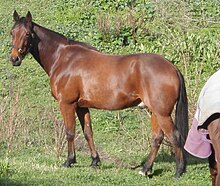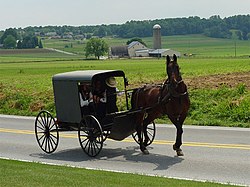Standardbred: Difference between revisions
Woohookitty (talk | contribs) m WikiCleaner 0.99 - Repairing link to disambiguation page - (You can help) |
No edit summary |
||
| Line 15: | Line 15: | ||
|}} |
|}} |
||
<!-- End Infobox Horse info. Article Begins Here --> |
<!-- End Infobox Horse info. Article Begins Here --> |
||
U HAVE NO LIFE |
|||
'''Standardbreds''' are a [[list of horse breeds|breed]] of [[horse]] best known for their ability to race in [[horse harness|harness]] at a [[trot (horse gait)|trot]] or [[horse gait#Pace|pace]] instead of under saddle at a [[gallop]]. Developed in [[North America]], the breed is now recognized worldwide for its [[harness racing]] ability. They are solid, well-built horses with good dispositions that are also used under saddle for a variety of [[equestrianism|equestrian]] activities, particularly in the [[Midwest]] and eastern [[United States]]. |
'''Standardbreds''' are a [[list of horse breeds|breed]] of [[horse]] best known for their ability to race in [[horse harness|harness]] at a [[trot (horse gait)|trot]] or [[horse gait#Pace|pace]] instead of under saddle at a [[gallop]]. Developed in [[North America]], the breed is now recognized worldwide for its [[harness racing]] ability. They are solid, well-built horses with good dispositions that are also used under saddle for a variety of [[equestrianism|equestrian]] activities, particularly in the [[Midwest]] and eastern [[United States]]. |
||
Revision as of 20:49, 15 September 2010
U HAVE NO LIFE Standardbreds are a breed of horse best known for their ability to race in harness at a trot or pace instead of under saddle at a gallop. Developed in North America, the breed is now recognized worldwide for its harness racing ability. They are solid, well-built horses with good dispositions that are also used under saddle for a variety of equestrian activities, particularly in the Midwest and eastern United States.
Breed history


In the 17th century, the first trotting races were held in the Americas, usually in fields on horses under saddle. However, by the mid-18th century, trotting races were held on official courses, with the horses in harness. Breeds that have contributed foundation stock to the Standardbred breed included the Narragansett Pacer and the Canadian Pacer, Thoroughbreds, Norfolk Trotter, the Hackney, and the Morgan. Breeders selected bloodlines that would produce the fastest horses, with one of the most notable sires being the gray Thoroughbred stallion Messenger, who was exported to the United States in 1788. He produced both runners and trotters. Messenger's descendant, the legendary Hambletonian 10, also known as Rydysk's Hambletonian, was born in 1849. He was sold, his owners thinking he was worthless, but later became one of the most prolific sires of Standardbreds, today with nearly every trotter or pacer tracing its lineage back to him.
The name "Standardbred" was first used officially in 1879, due to the fact that, in order to be registered, every Standardbred had to be able to trot a mile within the "standard" of 2 minutes and 30 seconds. Today, many Standardbreds race much faster than this original standard, with several pacing the mile within 1 minute, 50 seconds, and trotters only a few seconds slower than pacers. Slightly different bloodlines are found in trotters than pacers, though both can trace their heritage back to Hambletonian 10.
The Standardbred stud book was formed in United States in 1879 by the National Association of Trotting Horse Breeders.[1]
Breed characteristics

Standardbreds tend to be more muscled and longer bodied than the Thoroughbred. They also are of more placid dispositions, as suits horses whose races involve more strategy and more changes of speed than do Thoroughbred races. Standardbreds are considered people-oriented, easy-to-train horses. They are generally a bit heavier in build than their Thoroughbred cousins, but have refined, solid legs and powerful shoulders and hindquarters. Standardbreds have a wide range of height, from 14.1 to 17 hands (57"-66"),[citation needed] and most often are bay or the darker variation of bay called "brown", although other colors such as chestnut and black are not uncommon. Gray and roan are also found. The tobiano pattern is seen in some New Zealand-bred horses.
There are two basic types, trotters and pacers. As the name suggests, the trotter's preferred racing gait is the trot, where the horses' legs move in diagonal pairs, when the right foreleg moves forward so does the left hind leg, and vice versa. The pace is a two beat lateral gait; Pacers' forelegs move in unison with the hind legs on the same side.
However, the breed also is able to perform all other horse gaits, including the canter, and pacers can be retrained to trot.
Uses
Standardbreds are known for their skill in harness racing, being the fastest trotting horses in the world. Because of their speed, Standardbreds are often used to upgrade other breeds of harness racers around the world, such as the Orlov Trotter and French Trotter.
In Australia, Canada, New Zealand, the United Kingdom, and the United States, races are held for both trotters and pacers. In continental Europe, all harness races are conducted between trotters.

Major races for North American trotters include the Peter Haughton Memorial for 2-year-olds, and the World Trotting Derby, Yonkers Trot, Hambletonian, and Kentucky Futurity for 3-year-olds. The Hambletonian is sometimes referred to as the "Kentucky Derby of Harness Racing." The Trotting Triple Crown is made up of the Yonkers Trot, Hambletonian, and Kentucky Futurity.
Some of the major pacing races in North America include the Woodrow Wilson and Metro Stake for 2-year-olds, and the Little Brown Jug, Meadowlands Pace, North America Cup and the Adios Pace for 3-year-olds. The Little Brown Jug, the Messenger Stakes, and the Cane Pace comprise the Pacing Triple Crown. Major races in Australia and New Zealand include the New Zealand Trotting Cup, the Miracle Mile and the Inter Dominion series.
In 1968 New Zealand bred Cardigan Bay became the first Standardbred horse ever to win US$1 million dollars, and the ninth horse to do so worldwide (the first eight were Thoroughbreds). He was popular in the United States, and appeared with Stanley Dancer on the Ed Sullivan show as the "million dollar horse".[2]
Standardbreds are also used in horse shows and for pleasure riding. They are also popular as light buggy horses for the Amish people, who eschew motorized vehicles. Many retired Standardbreds find a second career off the track with the help of various dedicated organizations, such as the Standardbred Pleasure Horse Organization.
The breed is quite good at jumping, making them suitable for the sport horse disciplines of hunt seat, show jumping, show hunter and eventing. The breed is also seen in dressage, and their excellent temperaments make them good trail riding and ranch horses. In addition, because of the genetics of the breed, they can also be encouraged and trained to perform smooth ambling gaits, such as the rack and the stepping pace.
See also
References
- ^ The Stallion Place Retrieved 2010-2-8
- ^ Inter Dominion Championships Retrieved 2010-2-22

